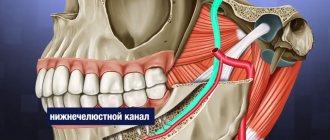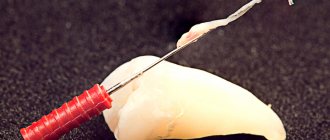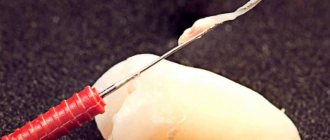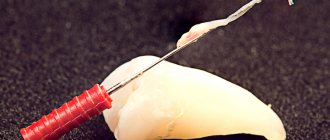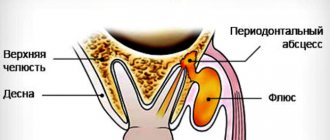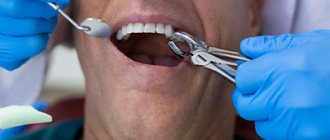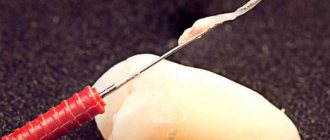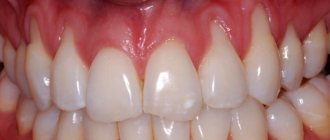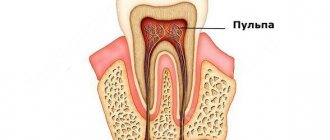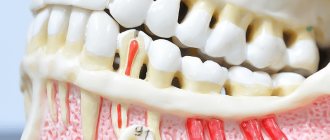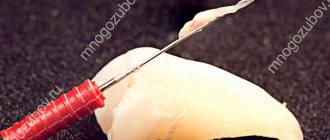Painless removal of a nerve from a tooth: how it goes and consequences
Many people are familiar with the procedure of removing a nerve from a tooth, which was accompanied by the mandatory placement of arsenic. Previously, this method took several days, during which the substance killed the nerve, after which the doctor removed the pulp and installed a filling or crown. Modern methods make it possible not to resort to arsenic, using more effective and painless methods. The pulp or neurovascular bundle performs important functions; it nourishes and protects tooth tissue from infection. Without it, the enamel changes color, hard tissues are destroyed faster, but in some situations, removal of the nerve is necessary.
Causes of dental pulp damage
The dentist is often visited because of caries - damage and destruction of enamel, which at the initial stage causes aesthetic discomfort.
Important: if the disease is started, the process affects the deeper layers of the tooth and pulpitis develops, that is, the neurovascular bundle becomes inflamed.
Pathologies arise due to the rapid proliferation of microbes, but in addition, the pulp can be damaged for the following reasons:
- gum disease, in which the neck of the tooth is exposed, the bone tissue is destroyed and harmful bacteria penetrate inside;
- trauma, as a result of which part of the tooth can break off, and then microbes enter the resulting cavity;
- mistake by the dentist who installed the filling or crown. If some actions were incorrect, then the nerve will make itself felt after a while.
These are the main causes of pulp damage. The symptoms of this condition will be acute. The pulp will begin to react to cold, hot, too spicy, sweet foods. Removing the nerve in such situations is a necessity, despite the fact that minerals and nutrients will stop flowing to the tooth.
Why do you need to remove the pulp?
We talked about the main reasons why nerve inflammation occurs, but most often pulpitis becomes a consequence of advanced caries. Therefore, it is very important to visit a dentist, even if nothing bothers you. The decision to remove the pulp is made in the following situations:
- pulpitis has passed into the stage of periodontitis, when inflammation affects the whole complex of connective tissue in the tooth;
- large area of carious lesion;
- the infection spreads through the apex of the tooth root;
- the appearance of unbearable, prolonged pain;
- spread of infection under an artificial crown;
- consequences of improper treatment.
The nerve can be removed either completely or partially, it all depends on the degree of tissue damage. Depulpation will prevent the spread of the inflammatory process under the crown and preserve the natural tooth, which is a priority for endodontic therapy.
When is depulpation performed before prosthetics?
Until recently, nerve removal was a routine process before the installation of permanent structures. Recently, the views of dentists have changed. The fact is that a tooth without pulp is considered “dead”. There is no tissue exchange, secondary dentin is not produced. He becomes fragile. In addition, when there is no pulp, the inflammatory process can completely destroy the tooth, because there will be no pain for a long time.
On the other hand, if the pulp becomes inflamed under the crown, then an expensive and complex restoration will have to be removed in order to carry out treatment.
There is no consensus among dentists whether it is necessary to remove the nerve during prosthetics. Each point of view has its defenders and opponents. The golden rule of dentistry is to carry out manipulations strictly according to indications.
How does the pulp removal process work?
We mentioned the method using arsenic at the very beginning. Some dentists still use it. The disadvantages of this treatment include its duration and pain. Before administering arsenic, the doctor must widen the root canal and place the substance into it. He then seals the area with a temporary filling. After two days, the arsenic kills the nerve, then the dentist cleans the substance from the tooth cavity and removes the pulp.
Important! Arsenic should not remain longer than expected in the oral cavity, as it is a poison and can be destructive to tissue.
There are more modern ways of performing the procedure, which are both safer and more painless. Before any action, an x-ray is required, which shows the vitality of the pulp, the length of the canal and other features.
Pulp removal is carried out using the vital and devital method. The first option is used for patients of any age. Its stages are as follows:
- the tooth is exposed;
- the pulp is removed with a special tool - a pulp extractor;
- a filling is installed.
In some situations it may be temporary and after a few days it changes to permanent.
Note: all stages of treatment are performed under anesthesia, so they will not be painful or uncomfortable for the patient.
The devital method is similar to what was used ten or more years ago, only instead of arsenic, a non-toxic substance is installed in the tooth cavity. The main method of pulp removal in modern dentistry is the vital method, when in just 1 visit to the doctor you can undergo complete painless dental treatment.
Important: temporary pain after a dental procedure is considered normal, as tissue intervention has occurred. If severe pain does not go away within 3 days, you should consult a doctor.
Treatment of pulpitis: review of modern treatment methods
When treating pulpitis, the most important task is to eliminate inflammation. For this purpose, conservative procedures or surgical methods that involve complete or partial removal of the pulp can be used. The doctor determines the type of treatment method for pulpitis individually for each patient, taking into account the form of the disease, as well as the stage of its development.
Conservative methods of treating pulpitis
If the patient does not self-medicate and at the first sign of pulpitis seeks professional medical help, then the disease can be treated using a conservative method and at the same time saving both the tooth and its nerve. The diseased tooth is drilled out so that the dentist has access to the pulp. It is treated with special antibacterial drugs and a medical gasket is placed on top, and the drilled tooth is closed with a temporary filling.
The patient will walk with the temporary filling for several days, after which he will return to the clinic for an X-ray. An image is taken to assess the quality of pulp treatment and if it shows that the inflammation has been stopped, the dentist will process the tooth canals, fill them and restore the tooth with a permanent filling.
USEFUL TO KNOW: Conservative methods of treating pulpitis will be effective if all procedures are carried out efficiently. Therefore, it is so important to choose the right dentistry for the treatment of pulpitis.
Surgical methods for treating pulpitis
The surgical treatment of pulpitis may involve either complete or partial removal of the dental nerve. The choice of a specific method depends on the stage of development of inflammation and is determined by the doctor after examining the patient and making a diagnosis. Most often, complete removal of the pulp is used: doctors are forced to make this choice for patients who came to the clinic for treatment of pulpitis too late, waiting for the inflammation to develop to a critical stage.
Complete pulp removal can be:
- Vital. This method involves extracting the dental nerve under anesthesia. To do this, the tooth is drilled with a drill, and all dental tissue affected by caries is removed. The drilled cavity is treated with an antiseptic and then the dentist, using a special tool, removes the pulp, and then fills the canals and tooth. This method is considered universal and suitable for the treatment of various forms of pulpitis, but it cannot be used for patients with allergies to anesthetic drugs;
- Devital. When choosing this pulp removal technology, the dental nerve is first exposed to toxic substances, which are placed in the form of a paste into the tooth cavity for up to 2 days. After the specified time has passed, the patient returns to the clinic, where the dentist removes the dead dental nerve from the tooth, treats the canals and places a permanent filling on the tooth.
This method of treating pulpitis is highly effective, but cannot be used in cases of purulent form of the disease or severe tissue necrosis.
Sometimes amputation is used as a method of treating pulpitis, which involves removing only part of the dental nerve. This method is not applicable for teeth with only one root, since in this case the dentist is not able to accurately identify individual parts of the dental nerve. Amputation is usually performed in the treatment of acute pulpitis.
In what situations should a nerve not be removed?
We are talking not only about contraindications, but also about cases in which the pulp can be preserved. The procedure is not performed if the patient has:
- any infectious disease;
- one of the forms of stomatitis;
- psychoemotional disorders;
- acute pathologies of the heart and blood vessels;
- unsatisfactory condition of the oral cavity with suppuration and inflammation.
The nerve is preserved if it is not subject to inflammation due to caries or other pathologies and injuries. The dentist’s task is to save the pulp and remove it only in case of emergency.
Important: you cannot endure a toothache and hope that the pain in your nerve will stop. Inflammation can become chronic and show almost no effect, but any provoking factor will affect the development of a purulent abscess. In this case, the minimal consequence will be tooth loss, and the possible consequence will be the spread of infection to other tissues.
Possible complications after depulpation
After the procedure, you may experience:
- Canal bleeding. The main reason for this phenomenon is the separation of the pulp by the pulp extractor. To avoid this problem, dentists practice gradual cutting of soft tissue using files and copious rinsing with an antiseptic. Only a doctor can stop canal bleeding.
- Short-term pain. Their duration may vary, but if they do not go away for a long time, it is necessary to re-open the canals and disinfect them.
- The appearance of a cyst, granuloma, gumboil or fistula.
- Facial paralysis. May occur due to improper application of material. If it protrudes beyond the upper part of the root, it will not only affect the tooth, but also compress the nerve of the jaw. That is why if you have pain in the chin area, you should immediately consult a dentist.
If disinfection is of poor quality during pulp removal, there is a risk of suppuration and the development of periodontal abscess. In this case, tooth extraction cannot be avoided.
Consequences of nerve removal
If the treatment was carried out by a professional and experienced dentist, then apart from slight pain the patient will not be bothered by anything. Otherwise, there may be such complications:
- a fragment of the instrument remains in the dental canal;
- the nerve was partially removed;
- incorrect or poor-quality filling of the canal;
- mechanical damage to the root or wall;
- rapid darkening of the enamel;
- suppuration due to poor disinfection.
Important! Depulpation at the Crystal clinic is carried out with the minimum possible complications, since all procedures are carried out by certified doctors with extensive experience using high-tech equipment and tools.
After depulpation, it is recommended not to eat for 2-3 hours, not to eat cold, hot, hard or other foods that irritate the mucous membrane. Your doctor will tell you in more detail about the necessary actions after removing the nerve.

